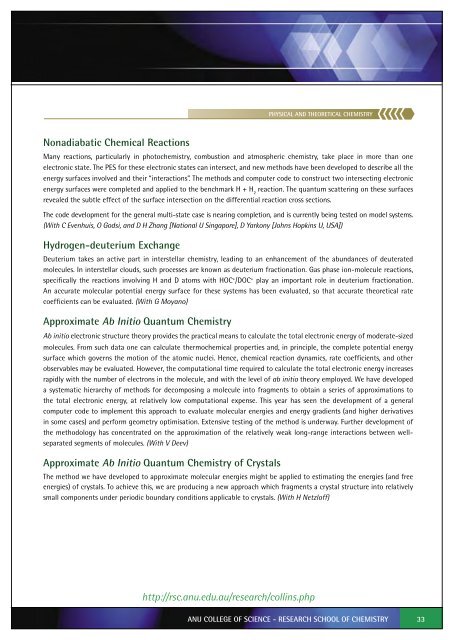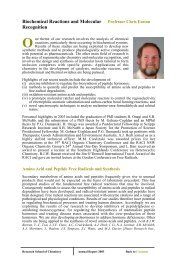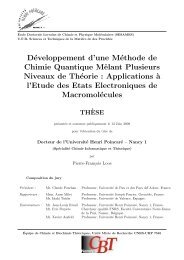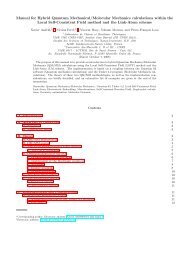View 2005 Report - RSC - Australian National University
View 2005 Report - RSC - Australian National University
View 2005 Report - RSC - Australian National University
You also want an ePaper? Increase the reach of your titles
YUMPU automatically turns print PDFs into web optimized ePapers that Google loves.
PHYSICAL AND THEORETICAL CHEMISTRY<br />
Nonadiabatic Chemical Reactions<br />
Many reactions, particularly in photochemistry, combustion and atmospheric chemistry, take place in more than one<br />
electronic state. The PES for these electronic states can intersect, and new methods have been developed to describe all the<br />
energy surfaces involved and their “interactions”. The methods and computer code to construct two intersecting electronic<br />
energy surfaces were completed and applied to the benchmark H + H 2<br />
reaction. The quantum scattering on these surfaces<br />
revealed the subtle effect of the surface intersection on the differential reaction cross sections.<br />
The code development for the general multi-state case is nearing completion, and is currently being tested on model systems.<br />
(With C Evenhuis, O Godsi, and D H Zhang [<strong>National</strong> U Singapore], D Yarkony [Johns Hopkins U, USA])<br />
Hydrogen-deuterium Exchange<br />
Deuterium takes an active part in interstellar chemistry, leading to an enhancement of the abundances of deuterated<br />
molecules. In interstellar clouds, such processes are known as deuterium fractionation. Gas phase ion-molecule reactions,<br />
specifically the reactions involving H and D atoms with HOC + /DOC + play an important role in deuterium fractionation.<br />
An accurate molecular potential energy surface for these systems has been evaluated, so that accurate theoretical rate<br />
coefficients can be evaluated. (With G Moyano)<br />
Approximate Ab Initio Quantum Chemistry<br />
Ab initio electronic structure theory provides the practical means to calculate the total electronic energy of moderate-sized<br />
molecules. From such data one can calculate thermochemical properties and, in principle, the complete potential energy<br />
surface which governs the motion of the atomic nuclei. Hence, chemical reaction dynamics, rate coefficients, and other<br />
observables may be evaluated. However, the computational time required to calculate the total electronic energy increases<br />
rapidly with the number of electrons in the molecule, and with the level of ab initio theory employed. We have developed<br />
a systematic hierarchy of methods for decomposing a molecule into fragments to obtain a series of approximations to<br />
the total electronic energy, at relatively low computational expense. This year has seen the development of a general<br />
computer code to implement this approach to evaluate molecular energies and energy gradients (and higher derivatives<br />
in some cases) and perform geometry optimisation. Extensive testing of the method is underway. Further development of<br />
the methodology has concentrated on the approximation of the relatively weak long-range interactions between wellseparated<br />
segments of molecules. (With V Deev)<br />
Approximate Ab Initio Quantum Chemistry of Crystals<br />
The method we have developed to approximate molecular energies might be applied to estimating the energies (and free<br />
energies) of crystals. To achieve this, we are producing a new approach which fragments a crystal structure into relatively<br />
small components under periodic boundary conditions applicable to crystals. (With H Netzloff)<br />
http://rsc.anu.edu.au/research/collins.php<br />
ANU COLLEGE OF SCIENCE - RESEARCH SCHOOL OF CHEMISTRY<br />
33






